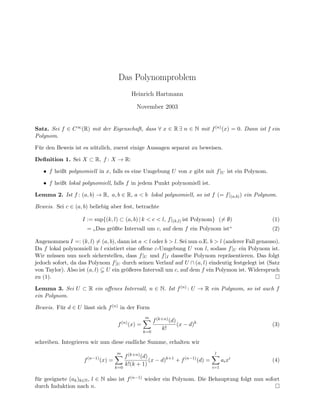
Polynomproblem
- 1. Das Polynomproblem Heinrich Hartmann November 2003 Satz. Sei f ∈ C∞(R) mit der Eigenschaft, dass ∀ x ∈ R ∃ n ∈ N mit f(n)(x) = 0. Dann ist f ein Polynom. F¨ur den Beweis ist es n¨utzlich, zuerst einige Aussagen separat zu beweisen. Definition 1. Sei X ⊂ R, f : X → R: • f heißt polynomiell in x, falls es eine Umgebung U von x gibt mit f|U ist ein Polynom. • f heißt lokal polynomiell, falls f in jedem Punkt polynomiell ist. Lemma 2. Ist f : (a, b) → R, a, b ∈ R, a < b lokal polynomiell, so ist f (= f|(a,b)) ein Polynom. Beweis. Sei c ∈ (a, b) beliebig aber fest, betrachte I := sup{(k, l) ⊂ (a, b) | k < c < l, f|(k,l) ist Polynom} (= ∅) (1) = ” Das gr¨oßte Intervall um c, auf dem f ein Polynom ist“ (2) Angenommen I =: (k, l) = (a, b), dann ist a < l oder b > l. Sei nun o.E. b > l (anderer Fall genauso). Da f lokal polynomiell in l existiert eine offene ε-Umgebung U von l, sodass f|U ein Polynom ist. Wir m¨ussen nun noch sicherstellen, dass f|U und f|I dasselbe Polynom repr¨asentieren. Das folgt jedoch sofort, da das Polynom f|U durch seinen Verlauf auf U ∩ (a, l) eindeutig festgelegt ist (Satz von Taylor). Also ist (a, l) U ein gr¨oßeres Intervall um c, auf dem f ein Polymon ist. Widerspruch zu (1). Lemma 3. Sei U ⊂ R ein offenes Intervall, n ∈ N. Ist f(n) : U → R ein Polynom, so ist auch f ein Polynom. Beweis. F¨ur d ∈ U l¨asst sich f(n) in der Form f(n) (x) = m k=0 f(k+n)(d) k! (x − d)k (3) schreiben. Integrieren wir nun diese endliche Summe, erhalten wir f(n−1) (x) = m k=0 f(k+n)(d) k!(k + 1) (x − d)k+1 + f(n−1) (d) = l i=1 aixi (4) f¨ur geeignete (ak)k∈N, l ∈ N also ist f(n−1) wieder ein Polynom. Die Behauptung folgt nun sofort durch Induktion nach n.
- 2. Lemma 4. Sei U ⊂ R offen, f ∈ C∞(U, R) lokal polynomiell auf (a, b) und (b, c), a, b, c ∈ R, (a, c) ⊂ U, dann ist f auf (a, c) ein Polynom. Beweis. Nach Lemma 2, sind f|(a,b) und f|(b,c) Polynome. Dann sind f|(a,b] und f|[b,c) auch Poly- nome (Stetigkeit). Entwickeln wir beide in b folgt Gleichheit. Satz von Bair 5. Sei E ein vollst¨andiger metrischer Raum, und An ⊂ E, n ∈ N abgeschlossene Mengen mit der Eigenschaft, dass E = n∈N An. Dann enth¨alt mindestens eines dieser An eine offene ε-Kugel. Zum Beweis dieses Satzes vgl. z.B. H.Heuser, Funktionalanalysis. Beweis des urspr¨unglichen Satzes. Wir beweisen den Satz in mehreren Schritten: 1. Zun¨achst brauchen wir zwei Bezeichnungen: C := {x ∈ R | f nicht lokal polynomiell in x} Mn := {x ∈ R | f(n) (x) = 0} = (f(n) )−1 ({0}) 2. Eigenschaften von C und Mn: R = n∈N Mn (5) Das Komplement von C ist offen, da es Umgebung aller seiner Punkte ist, also ist C abge- schlossen. Als Urbild der abgeschlossenen Menge {0} unter der stetigen Abblidung f(n) sind alle Mn abgeschlossen. 3. C enth¨alt keine isolierten Punkte, denn w¨are y ∈ C ein solcher Punkt, so w¨urden Intervalle (x, y) und (y, z) exsitieren, mit f|(x,y) und f|(y,z) Polynom. Nach Lemma 4 ist nun f auf der Umgebung (x, z) von y ein Polynom. Widerspruch zu y ∈ C. 4. C ist als abgeschlossene Teilmenge von R vollst¨andig und mit der Standardmetrik auch ein metrischer Raum. Nehmen wir also an, C sei nicht leer, dann liefert der Satz von Bair f¨ur C: (Mn) ist eine abgeschlossene ¨Uberdeckung von R, also auch von C ⊂ R. Es folgt: ∃ k ∈ N, t ∈ C, ε > 0 so, dass Uε(t) ∩ C ⊂ Mk (6) 5. Wir betrachten nun ein beliebiges (aber festes) x ∈ Uε(t)∩C. Wir wissen aus (3), dass x kein isolierter Punkt von C ist, also muss x ein H¨aufungspunkt von C sein. Damit h¨auft sich auch Uε ∩ C und somit Mk also die Nullstellen der k-ten Ableitung in x. Mit dem Satz von Rolle 1 folgt zun¨achst dass sich die Nullstellen von f(n+1) in x h¨aufen und weiter per Induktion: f(n) (x) = 0 ∀ n ≥ k (7) Da jedoch x ∈ Uε ∩ C beliebig war, ist diese Aussage auch f¨ur alle Punkte aus Uε ∩ C wahr: f(n) |Uε(t)∩C = 0 ∀ n ≥ k (8) 1 Zwischen zwei Nullstellen einer stetig differenzierbaren Funktion liegt auch immer eine Nullstelle der Ableitung.
- 3. 6. Nun wollen wir noch eine Aussage f¨ur das Komplement von C in Uε gewinnen. Sei jetzt x ∈ Cc ∩ Uε. Wir betrachten nun die Zusammenhangskomponente (r, s) von x, also das gr¨oßte Intervall in Cc das x enth¨alt. Klar: f|(r,s) ist ein Polynom. Da nach wie vor der Mittelpunkt t von Uε in C liegt, ist sichergestellt, dass wir mit (r, s) ⊂ Cc nicht an beiden Seiten aus Uε herauslaufen. Sei also o.E. r als Randpunkt von Cc Element von C ∩ Uε 2. Wir k¨onnen das Polynom f|(r,s) um r entwickeln: f|(r,s)(x) = m k=1 f(k)(r) k! (x − r)k (9) Da jedoch r ∈ Uε(t) ∩ C ⊂ Mk, wissen wir, dass f(n)(r) = 0 ∀ n ≥ k. Es folgt: f(n) |(r,s) = 0 ∀ n ≥ k (10) 7. Damit haben wir nun alles, was wir brauchen: x war aus Cc ∩ Uε beliebig gew¨ahlt, damit ist f(k) |Cc∩Uε = 0 (11) und f¨ur C ∩ Uε haben wir diese Aussage schon in (5) gewonnen. Wir haben also f(k) |Uε = 0 (12) Nach Lemma 3 ist dann f|Uε ein Polynom, also ein Widerspruch zu t ∈ Uε ∩ C. C musste also leer sein. 2 Zur Erinnerung: C abgeschlossen, Cc offen vgl. (2).
